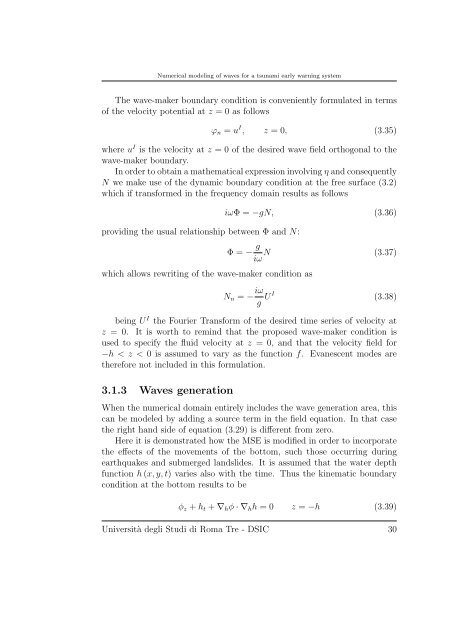Numerical modeling of waves for a tsunami early warning system
Numerical modeling of waves for a tsunami early warning system
Numerical modeling of waves for a tsunami early warning system
Create successful ePaper yourself
Turn your PDF publications into a flip-book with our unique Google optimized e-Paper software.
<strong>Numerical</strong> <strong>modeling</strong> <strong>of</strong> <strong>waves</strong> <strong>for</strong> a <strong>tsunami</strong> <strong>early</strong> <strong>warning</strong> <strong>system</strong><br />
The wave-maker boundary condition is conveniently <strong>for</strong>mulated in terms<br />
<strong>of</strong> the velocity potential at z = 0 as follows<br />
ϕn = u I , z =0, (3.35)<br />
where u I is the velocity at z = 0 <strong>of</strong> the desired wave field orthogonal to the<br />
wave-maker boundary.<br />
In order to obtain a mathematical expression involving η and consequently<br />
N we make use <strong>of</strong> the dynamic boundary condition at the free surface (3.2)<br />
which if trans<strong>for</strong>med in the frequency domain results as follows<br />
providing the usual relationship between Φ and N:<br />
iωΦ =−gN, (3.36)<br />
Φ=− g<br />
N<br />
iω<br />
which allows rewriting <strong>of</strong> the wave-maker condition as<br />
(3.37)<br />
Nn = − iω I<br />
U<br />
g<br />
(3.38)<br />
being U I the Fourier Trans<strong>for</strong>m <strong>of</strong> the desired time series <strong>of</strong> velocity at<br />
z = 0. It is worth to remind that the proposed wave-maker condition is<br />
used to specify the fluid velocity at z = 0, and that the velocity field <strong>for</strong><br />
−h

















